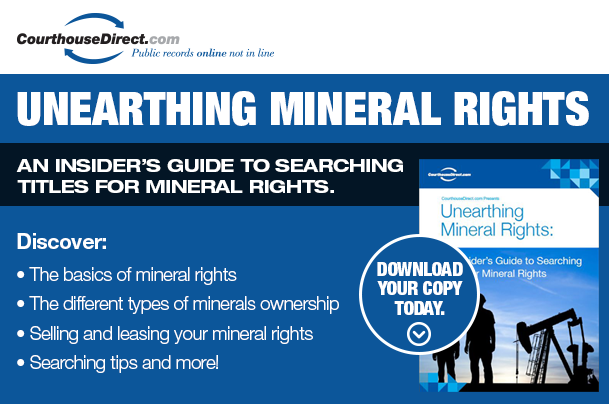
If a landowner wishes to benefit financially from minerals lying below the surface, the owner can split or sever the property into two separate interests — the surface and the mineral-rich portion beneath it. The surface estate can then be used or sold separately from the mineral interests.
In this manner, a landowner can sell the surface property, yet retain the rights to the minerals beneath it.
The ability to sever the mineral rights from the surface property has a particular appeal to owners of property in gas and oil-rich locations. The mineral rights, or interests, after separation from the surface, can be retained or sold as the landowner wishes through a mineral deed or a royalty deed.
A deed is also known as a conveyance or reservation.
An essential element of severing property into two separate interests is that once separated; the interests must be handled as separate legal entities from then on.
Each is a different instrument for conveying property and mineral rights; unfortunately, it can be difficult to discern which type of deed is in force on a particular property. Let’s take a look at what a mineral deed and royalty deed are and how they differ.
Mineral Deeds
A mineral deed provides the holder with executive rights pertaining to the property beneath the surface.
- The deed holder is given a “reasonable surface use” or provision to enter, use and improve the property in the course of extracting the minerals.
- The deed holder is fully licensed to extract and sell those minerals.
- The deed holder has the power to create and execute additional leases for a third party extraction company or another entity.
- The deed holder has the full authority to earn and keep the income associated with the leases.
- Ownership reverts to the deed holder upon the expiration of third-party leases.
With these rights, the deed holder can control the means by which the minerals are extracted and transferred for sale, and reap the financial benefits. The holder of the mineral deed also has the right to receive lease bonuses, delay rental payments, shut-in payments and royalties.
A mineral deed can convey all or part of the mineral rights. Someone can own a percentage of the mineral rights granted by the deed while a separate party can own another percentage.
However, the mineral deed holder is not permitted to take over the entire surface for extraction activities and has no ownership of any buildings on the surface. Also, the mineral deed holder may not bar the surface owner from entry to or use of the property.
A mineral deed may contain a title warranty, or it can be a quitclaim deed. In a quitclaim deed, the title is not warranted.
Royalty Deeds
A royalty deed is more restrictive than a mineral deed. Another name for a royalty deed is “non-participating production interest.” In this case, the deed holder has fewer rights and less control over the property below the surface.
- There is a complete restriction on the royalty deed holder’s right to exploit and sell the minerals within the property.
- The deed holder has no right for ingress or improvement of the land.
- The deed holder has no responsibility for production and improvement costs.
- There are no third-party lease-granting rights.
In addition, the deed holder has no right to any income or bonuses associated with third-party leases or mineral sales. The only financial remuneration a royalty deed holder may receive is a percentage of the profits from the sale of the minerals if they are produced.
In other words, the royalty deed holder's only right is to receive royalties, and those royalties are available if the minerals are extracted and sold.
If the entity holding the mineral rights does not produce any minerals, no royalties are paid.
Mineral Deed vs. Royalty Deed
You can already see one difference between the two deeds. A mineral deed is less restrictive and grants more rights over the mineral interest than a royalty deed.
The second distinction between these types of deed has to do with the size of the financial stake.
The mineral deed holder receives a higher reward but at the cost of higher risk. Only the mineral deed holder can improve, extract, and sell any minerals found in the deeded land, and receive a majority of the profit.
The royalty deed holder, on the other hand, is restricted to receiving a percentage of the royalties from the sale of the minerals and has no authority or responsibility for mining and extraction.
The royalty deed holder cannot grant third-party leases to the property. Only the mineral deed holder may grant leases. Besides, the deed holder may not receive lease bonuses, delay rental payments or shut-in payments.
The Challenge of Identifying the Different Types of Deeds
While the explanation above seems to make the difference between a mineral deed and a royalty deed rather clear-cut, that is not always the case. The language of the deeds may not express the various executive and royalty rights plainly, especially in older deeds.
Some deeds are vaguely worded while others were written in an earlier time, and the interpretation of the language has changed. Deed holders and potential purchasers may find themselves seeking a legal remedy in cases of disagreement about the identity of the deed.
Another issue arises from differences in state policy regarding the granting and execution of mineral and royalty deeds. Each jurisdiction has its own law and language.
Deed holders must pay particular attention in a few cases.
- In and under typically mean the deeds including these words confer full mineral rights unless the contract explicitly specifies otherwise.
- Produced and saved, used in combination are assumed to confer royalty
- Profit share and share of profits are generally assumed to confer full mineral
- The phrase non-participating almost always describes a royalty
Here is an example where the interpretation may not be apparent:
A deed granted by the first party conveys to the second party “a 1/2 interest in all of the royalty oil in and under Blackacre.”
Upon first reading, the sentence seems to say that the first party is conveying a royalty deed only because the word royalty is used. However, because the words in and under are used, it seems to imply the first party is conveying a mineral deed.
The apparent discrepancy may be resolved by analyzing the grant in its entirety, in conjunction with the provisions of the contract or interest to reach the correct interpretation.
If, instead, the grant containing the above sentence added the statement, "The second party shall also have the right to drill and produce oil and gas from said premises," the issue is clarified, and you can be reasonably confident the grant is a mineral deed.
If you have any uncertainty about whether a deed is a royalty deed or a mineral deed, consult with a qualified oil and gas attorney to help you with the proper interpretation. Such consultation can reduce the need for legal action from any party.























